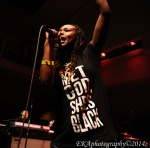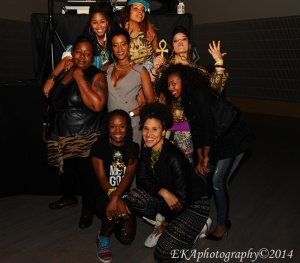Live review/ “Clas/sick Hip-Hop: 1993 Edition,” Nov. 7 & 8, Yerba Buena Center for the Arts
In a two-night run filled with memorable moments, “Clas/sick Hip-Hop: 1993 Edition”’s biggest flashpoint came about halfway through the second night. A remarkable set of canonical hip-hop, played live by the Kev Choice Ensemble, segued from Digable Planets’ “Rebirth of Slick (Cool Like Dat),” to the Conscious Daughters’ “Fonky Expedition,” to Queen Latifah’s “U.N.I.T.Y.” The first song, performed by Aima the Dreamer and Sayknowledge, sent shivers through the sold-out crowd, as Aima channeled Ladybug Mecca’s cool breeziness over an acoustic bassline originally played by Art Blakey’s Jazz Messengers. The second, performed by Coco Peila and Ryan Nicole, brought back memories of a time when good local rap regularly earned rotation on commercial stations. And the third, which featured a strident, commanding Zakiya Harris, flanked by Aima, Peila, Nicole and vocalist Viveca Hawkins, evoked a sea of epiphanies, none greater than the notion that Harris and Co. had tapped into hip-hop’s elemental womb and stuck a chord of long-overdue gender balance, releasing a flood of amniotic lyrical fluid which coated the audience’s ears with sticky bliss. Hip-hop may be a mostly male-dominated art form, but in keeping with YBCA’s Left Coast ideology, the Bay Area’s female emcees reigned like queens.
As if to underline the point, Coco Peila followed with a jaw-dropping cover of 2Pac’s “Keep Ya Head Up.” The song—one of the rap icon’s most positive and uplifting—took on an even deeper meaning with a woman rapping its words: And since we all came from a woman/ Got our name from a woman and our game from a woman/ I wonder why we take from our women/ Why we rape our women, do we hate our women?/ I think it’s time to kill for our women/ Time to heal our women, be real to our women/ And if we don’t we’ll have a race of babies/ That will hate the ladies, that make the babies/ And since a man can’t make one/ He has no right to tell a woman when and where to create one/So will the real men get up/ I know you’re fed up ladies, but you gotta keep your head up.
Hawkins killed it on the hook— an interpolation of the Five Heartbeats’ “Ooh Child”—then, after 1-O.A.K. responded with a dead-on Mayfield-esque falsetto during HNRL’s take on Outkast’s “Player’s Ball,” she returned to tackle SWV’s underrated yet seminal R&B hit “Right Here,” completely nailing the high notes of the hook. As if that wasn’t enough, bandleader Kev Choice crept out from behind his array of keyboards to rap a verse from Nas’ “It Ain’t Hard to Tell” – whose remix sampled the same Michael Jackson “Human Nature” melody as the SWV song. It was that kind of night.
If social media chatter is to be believed, “Clas/sick Hip-Hop: 1993 Edition” is already being talked about as being legendary. It’s difficult to disagree with that assessment, although the word “epic” might work equally as well. The brainchild of YBCA’s Marc Bamuthi Joseph, the impetus for the production was simple but brilliant: revisit 1993, a particularly great year for hip-hop albums, with not one but two live bands and a gaggle of local emcees – all doing music which came out that year. Into that mix, add an a cappella youth chorus, some of the best local deejays and hip-hop dancers, montages of music videos of the songs performed by artists, and interviews with local culturati explaining the significance of ’93 in a cultural, social, political, and personal sense.
Both nights started out with a DJ set – Kevvy Kev on Friday; DJ Fuze on Saturday – which was punctuated by a flash mob consisting of the YGB Gold a cappella singers, who performed a medley of KRS-One’s “Black Cop” and “Sound of Da Police.” The medley underscored the relevance and timelessness of the ‘93 hip-hop canon (though it’s somewhat dubious to note both songs address police misconduct, of which the latest flashpoint is #Ferguson).
The set list flowed like a mix tape; Calafia Zulu member K-Swift followed with Black Moon’s “How Many Emcees,” a song based around a KRS sample, then jumped into “I Got Cha Opin,” which afforded the musicians the opportunity to wrap their instruments around the Barry White sample which informs the song. Hornsmen Geechi Taylor and Howard Wiley were up to the challenge.
Two braggadoccious epochs of masculine bravado, Masta Ace’s “Born to Roll” and Dr. Dre’s “Ain’t Nothing But a G Thing” were sandwiched around Del’s lyrical sucker punch, “Catch a Bad One” (performed by Wonway Posibul of the Latin Soul Brothers). Not that the Del track lacks for boastfulness, but it’s decidedly less commercial and contrived, and built around a sublime Eric Dolphy sample – replayed with aplomb by the KCE, who had the daunting task of having to learn 20 songs in a short period.
The other live band performing was Ensemble Mik Nawooj. The hip-hop/classical fusion outfit performed songs by Wu-Tang and Snoop Dogg, and emcees Do D.A.T. and Sandman were energetic and animated. However, an opera singer notwithstanding, the static nature of their set (and, perhaps, the absence of a bass player) couldn’t compare to the vibrant dynamic laid down by Choice, his band, and their guests at the other stage. By the second night, the differences were painfully apparent; some people walked out during Mik Nawooj’s second set. Which was unfortunate, because they missed the Tribe Called Quest medley which vamped around the bassline from Freddie Hubbard’s “Red Clay” and brought the show to a groovy simmer, as well as the closing free-for-all freestyle rhyme cipher. Which was ridiculous on both nights.
The female emcees brought the spark which ignited the show’s flame. But credit must be given to Choice as a musical director for the way things turned out. The KCE flipped samples inside-out, returning breakbeats to their jazzy essence and reminding folks that the ‘93 flavor was as musical as it was lyrical. Choice himself spent most of the night behind the keyboards, paying tribute to the Bay Area’s contribution to the year by rapping on Saafir’s “Light Sleeper” and Souls of Mischief’s “93 til Infinity.” There were other subtle nods to the Bay, like the melodies from Mac Mall’s “Sick Wit Tis” and Too $hort’s “Getting It” the band played during the freestyle cipher.
The night was billed as one which gave long overdue props to the poets of one of the most remarkable years in hip-hop’s Golden Era. But it ended up being much more than that. True, ’93 was a year when hip-hop’s creative expression was at its peak and the music industry hadn’t yet figured out what parts of the culture it wanted to emphasize and what parts it wanted to suppress. Yet in retrospect, the beats emcees rapped on back then were at least as much a part of the era’s greatness as the rhymes. We’ll never see those days again, not just because rap has changed, but also because the sampling aesthetic no longer plays such a central part in hip-hop.
“Clas/sick Hip-Hop: 1993 Edition” reveled in nostalgia for a bygone era, but that’s not all it did. It brought an appreciation of hip-hop culture to an institutional space without killing the jazzy, funky, lyrical vibe of that culture. And it did so through live instrumentation, in effect going above and beyond how the music was presented at the time of its emergence. By raising the musical bar, the production ushered in another refutation of space and time, to paraphrase Digable Planets, which shone a bright spotlight on the current generation of Bay Area hip-hop artists (most of whom hailed from Oakland). But the brightest lights blazed on the local female emcee contingent. So often an afterthought on hip-hop bills, or consigned to a segregated performance space, in “Clas/sick Hip-Hop’s” re-envisioning of ‘93’s cultural legacy, the women of hip-hop not only played a central role, but manifested a sisterhood of solidarity while showing that they indeed had the props.












Pingback: 2014: The Year in Oakulture | oakulture
Pingback: Women Runnin It: Interview with Soulovely crew’s Lady Ryan, Aima the Dreamer and DJ Emancipacion | Oakulture